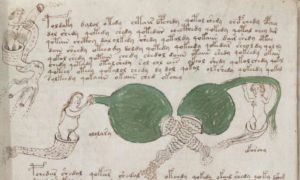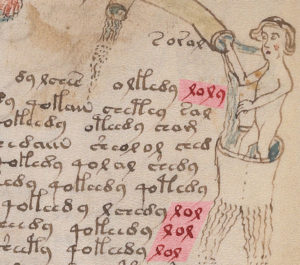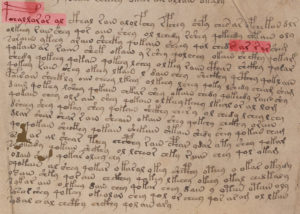Incidental news: Cipher Mysteries recently had its 25,000th comment, while it has now also had close to three million page views. Which is nice. (Just thought I’d mention it in passing.) The remainder of the post is for tying up various Voynich threads that aren’t each enough for a whole post of their own.
Edith Zimmerman
Here’s a Voynich amuse-bouche: any page with drawings taken from the Voynich Manuscript’s Quire 13 that includes the following quote is more than OK by me:
Anyway, so then we got to the part in our performance where Shelly and Mathilde stand in giant pipes covered with rhinestones. They hold up large balloons that have fishtails dangling off them, Chinese dragon-style.
Voynich LOL
An example of the per-section language use in Voynichese is that the word EVA “lol” appears far more often in quires Q13 and Q20 than anywhere else. Here’s the lol cluster in the top paragraph of f77r (1 x loly, 3 x lol, all at the end of lines):
Aside from Q13, EVA lol also appears here: f48v f86v6 f103r/v f106r f107r/v f111v f113v f115r f116r. Incidentally, the first word of the last paragraph of f116r (which I suspect contains a colophon from the author) seems to me to be the same kind of thing as the heavily digraph-structured labelese words, though with the extra twist of EVA l sometimes standing in for ol, as I discussed elsewhere):
Brian Hendley
The recent talk of Canadian academics’ rogue AI’s preparing for the enslavement of Mankind by solving Voynichese triggered some memories in the head of Brian Hendley, a philosophy professor at the University of Waterloo:
Your recent story about deciphering the mysterious Voynich manuscript took me back to my graduate school days at Yale and my dissertation supervisor, Bob Brumbaugh. Bob was a recognized Plato scholar but he did have a crack at deciphering the Voynich manuscript, resulting in some published articles and a book, “The Most Mysterious Manuscript: The Voynich ‘Roger Bacon’ Cipher Manuscript.” I recall Bob saying that you could spend your entire scholarly career trying to decipher the Voynich.
Ain’t that the truth, eh? *sigh*
Gerard Cheshire (yes, again)
Polyglot linguistic Voynich theorist Gerard Cheshire (whose theory I discussed here back in 2017) has hurtled into 2018 even more convinced of his utter rightness (and of everyone else’s abject wrongheadedness).
If you really, really want to read his all-new polyglot interpretation of the nine rosette page (which he calls “Tabula regio novem”, which I don’t believe is grammatical Latin, whatever Google Translate may say) which is all about Italian volcanoes, it is online here.
For those whose appetite for such things would be easily assuaged by a single dim sum, here is Cheshire’s elucidation (I hesitate to call it a decryption or translation) of the text around the bottom-left (SW) rosette:
om é naus (people and ship)
o’monas (in unity)
o’menas (take charge)
omas (mothers/babies)
o’naus (of ship)
orlaus [orlas] (to protect)
omr v asaæe [vasaie] (life-force pots: pregnant bellies)
or as (yet in)
a ele/elle a (he/she at)
a inaus [inauspitica] (inauspicious/unfavourable),
o ele e na (he/she is in)
æina (a/one)
omina (omen)
olinar (to look)
n os aus (it is)
omo na moos (man not mouse)
é ep [epousee] as (and embrace)
or e ele a opénas (an opening)
os as ar vas (thus you go)
opas (but carefully)
a réina (to the queen)
ol ar sa os aquar aisu na (to facilitate not getting wet with seawater).
J. Michael Herrmann
One little-noted Voynich theory from last year was J. Michael Herrmann’s The Voynich Manuscript is Written in Natural Language: The Pahlavi Hypothesis. Exactly as it says on the tin, it’s a linguistic Voynich theory:
Here, we provide evidence that the VM is written in natural language by establishing a relation of the Voynich alphabet and the Iranian Pahlavi script. Many of the Voynich characters are upside-down versions of their Pahlavi counterparts, which may be an effect of different writing directions. Other Voynich letters can be explained as ligatures or departures from Pahlavi with the intent to cope with known problems due to the stupendous ambiguity of Pahlavi text.
Herrmann followed that with his 2018 paper The Cannabis Page of the Voynich Manuscript. This finesses some of the claims in the 2017 paper, now suggesting that Voynichese uses an “alphabet that has similarities to Pahlavi and Mandaic script”.
The “Cannabis Page” referred to in the title is f16r:
In Herrmann’s translation (which is accompanied by extensive notes, presumably to help readers overcome the “stupendous ambiguity” of Pahlavi), the first paragraph of f16r emerges as a tirade against the evils of cannabis:
Cannabis [is] vain. Stay away from the impudent crowing man. The pipe is a debasement. Jaundice [is] the overly happy face of the adherent. [He is] puffed up with pride. Security does not come [to him]. In the evening peace of mind does not come [to him, as] the serpent of nightly lust spoils him. [What is] concealed,
will become public.
If you are interested, Herrmann’s rendering of the first paragraph of f1r is as follows:
(1) The humble grass shames you. Obediently hold the law. You cry for help for the tribunal commanded (2) for being insolent. Verily, you are frightened out of your wits by the troops in fury. Crowds and crowds of abled ones. (3) Woe, the well ordered line (of troops) is driving forward. If you see this, you will. Don’t start to count and to number the men, woe! (4) Refrain form [sic] the uneducated baldhead, the storyteller, the teaching of the “light bringer”. Remember the time of the fathers. (5) Heaven shield those who are weak for debasement. The man of doubt guide right.
If only I had an open letter I could use, if only… :-/




Post from a long-time Voynich researcher, Patrick Lockerby, setting out his reasons for thinking the Voynich text is abbreviated Latin
https://www.science20.com/patrick_lockerby/patterns_of_latin_in_the_voynich_manuscript-225418
Lockerby is not on the voynich.ninja ‘blogosphere’ and I don’t treat the question of languages, so I hope Nick that you won’t mind my posting the information here.
Diane, Patrick’s “decipherment” was discussed at length on the forum when he first announced it a year-and-a-half ago. His decipherment is not readable as Latin, it’s just nonsense words that look a bit like Latin because Latin endings have been added.
Also, his logic of expanding every “Latin abbreviation” in the same way (he’s doing it with a computer algorithm) doesn’t work either. The expansion of Latin abbreviations is situational and sometimes also positional. In other words, the same abbreviation has different meanings, and Lockerby didn’t factor context into his decipherment algorithm.
JKP
Patrick has been around a lot longer than you may realise – certainly longer than you or the new (ninja) forum…
A discussion on that forum is rarely representative of opinions past or present, but only those of whoever happens to have remained a member.
Since the 1930s, the view has been general, whether expressed tacitly or overtly, that the text should prove to be Latin.
For myself, I doubt it, because my iconographical analyses (also preceding your arrival in the field) led me to a different conclusion.
However, given that thinkers as fine as Tiltman and Neal have thought so (see original research contributed to the first mailing list), one has to be willing to consider both sides of the balance.
And Lockerby’s deserves consideration on the ‘Latin’ side.
I might point out that when pretty much everyone (especially those creating the ‘central-European=alchemical-occult- Jesuits-stole -it’ adventure tale were pottering around the wrong place (Prague) and the wrong time (late sixteenth and seventeenth century), Lockerby had already dated the manuscript to the early 15thC (pre-1440).
He may be right; he may be wrong, but scholars to not dismiss an academic argument by looking down their nose, sneering and appealing to the crowd to attack the source of dissent.
Do they?
Diane, anyone can *guess* the VMS is Latin.
It is clear from Lockerby’s “translation” that he does not know Latin and he clearly does not know how to correctly expand Latin abbreviations, which are positional and situational. If one knows Latin, one can see that immediately.
The computer algorithm he developed for translating the Voynich text DOES NOT GENERATE LATIN. All it does is take short syllables (a simple substitution code) and add Latin endings. It doesn’t even use the variety of endings that are part of the scribal repertoire for each Latin abbreviation—it is a logically undefendable “mono” translation.
The result is nonsense words. There is no Latin vocabulary or Latin grammar in his solution. It’s just computer-generated gobbledy-gook.
Diane wrote: “…scholars to not dismiss an academic argument by looking down their nose, sneering and appealing to the crowd to attack the source of dissent.”
I did no such thing. I analyzed his translation. If you had read the discussion on the forum, you would have known this. If you knew Latin and tried to read Lockerby’s “translation”, you would have known this.
You are defending a translation made up of nonsense words.
JKP – I’m not defending anything – as I said I’m not inclined towards the idea of the text as in Latin at all.
What I do think is that everyone is entitled to fair hearing… and when I said “we” don’t meet an argument with non-rational behaviour like sneers and looking-down-the-nose, I was including you among the persons who DON’T do that, wasn’t I?
Do you know Charles’ Burnett’s work at all? You may find it interesting – together with some recent studies done of Spain, Acre and Antioch.
Here is an excerpt from Lockerby’s translation. How many Latin words can you find in this? You will have to look at a medieval Latin dictionary (words that were in use in the 15th century):
“…ileumeses esetarus estlietnus oilanrus eteum rusetum ferolioque lietquees esqueota estoil etorus eteum…”
This is not Latin.
Diane: lots of what Lockerby wrote is fairly reasonable (particularly when he quotes Cipher Mysteries 😉 ). At the same time, I personally think he was backing a one-legged mule for the Grand National when he fell in with Baghdad (for the central rosette), while his ideas trying to link Latin to Voynichese aren’t a great deal better. How fair a hearing do things that are basically wrong from start to finish merit?
Nick: And so say all of us; For most Voynicherios would fall into that category, whether they accept it or not. Let me be the first to put my hand up, not that I merit much of a hearing. Anyone with better credentials care to fess up, be my guest!…
Nick,
I think that *a lot* of what is said about the manuscript is ill-considered and ill-researched.
I quote ciphermysteries too. I trust your documentation and ethics in such things.
Also, this is the only Voynich arena which permits a certain intellectual latitude; I mean you seem to see debate as a positive thing – a means to refine ideas, rather than a weapon to enforce a monoculture.
I don’t agree with Patrick that the map’s centre represents Baghdad, but so long as there’s widespread doubt over what it *does* represent, there’s always the possibility that he’s right. (I think I remember, when I published the analytical study of that folio, that Rene said he had the ‘idea’ it might be Baghdad, too. So there are two people who’ve offered that idea.)
I agree only that there are a few things proven beyond reasonable doubt: (i) that the material is rough vellum; (ii) that the top eleven quires returned a radiocarbon range (adjusted) of 1404-1438; (iii) that the binding (and my own survey of quire-sizes) suggests manufacture most likely in northern Italy.
I wish I could rely on a general acceptance that Mnishovsky was a liar but I don’t suppose that’s going to happen for a bit longer, yet. 🙂
Diane: (i) examined up close (I spent three days working with it), the Voynich Manuscript’s vellum is actually pretty good quality – not really fancy ‘royal proclamation’ stuff, sure, but I don’t think categorizing it as ‘rough vellum’ is fair or accurate. (ii) thin edge strips were cut off from only four bifolios, the range of radiocarbon dates varied across the four, and given that I remain unpersuaded by the earliest one of the four, I think it’s fair to say that the headline “1404-1438” date isn’t (yet) quite as certain as you describe.
Personally, I’d add as racing certainties (a) that most of the marginalia are mid-to-late fifteenth century, (b) the the zodiac roundel drawings were copied from a single German manuscript source not at all unlike Diebold Lauber’s workshop, and (c) the scribes who wrote the Voynichese text had previously been trained to write in a humanist hand in an urban centre (probably in Northern Italy).
I’m not sure “a general acceptance that Mnishovsky was a liar” is going to happen any time soon. You might well have an equally long wait for a partial acceptance of the same.
Nick. Two birds of a feather having a grand old cock fight over Santa’s way, spurs and all. I’m lovin’ the joust, egos hurt, plumage ruffled, with no holds barred and both combatant’s primary colours being revealed at last. Rene’s remarks about he having forgotten more than Rich’s ever having known about VM…offensive and the like being order of the day. Can’t say that I have a bird in the ring, with both obviously feeling that their opponent’s views are only fit for scorn. Got any thoughts on these brave bird’s respective claims of ’03’s provinance boss?
John: the whole 1903 claim thing seems entirely consistent with what we know, but a little more documentary evidence would be nice. To be honest, my interests with the Voynich’s provenance lie almost exclusively in the pre-1622 period (Tepenecz died in 1622), so this is a cockfight for other birds entirely.
Nick: To be fair, Rene’s comment on VM authority was with reference to a Roger Clemens. For a moment there I thought he meant Samual Clemens aka Mark Twain, who’s middle name Leghorn or similar, is of course a breed of chicken.
Hi John,
Raymond Clemens is Curator for Early Books and Manuscripts at the Beinecke Rare Book & Manuscript Library at Yale.
Roger Clemens was a MLB pitcher with the Yankees and Red Sox, among others.
The Voynich Manuscript certainly throws a few curveballs, but not that way!
Hi Nick, there is quite considerable documentary (and other) evidence related to the collection of which Voynich was allowed to buy part. In case you have any questions or doubts, just drop me a line.
I do agree that more of it would be welcome, of course, and this remains on-going work. Even last December another missing piece of the puzzle surfaced, but there are still large holes.
Diane,
It is possible I’ll be putting together a paper focusing on crypto-side issues rather than imagery, but even so I’d like to cite your work in the “Related Work” section. Is there a stable public URL that could be referenced offering a summary of your views?
Thanks,
Karl
Let’s throw some oil into the fire, which concerns the VM – text.
I picked out a text where I thought it could be a rhyme, verse or song. Because it’s very strange, and very simply written.
I rely on my experience and the key where I work.
Since the thread is not broken to this day, I think that I at least apply the right way of thinking.
The text is from the edge ring, the upper, middle rosette. Start at the marking, about half the ring.
Even if it looks a bit strange, it is certainly worth talking about it.
Criticism desired.
etate it at i at a at a cis
a cis a at is is unum cis as
a at is os as is sat
a noti a not a cies a nea stus
I at a side of it at their age at a
take a look at it from the side of one side of it as
But this is not the bone as it is sufficient
His known from the surfaces will not straight from the heat
There is a key to cipher the Voynich manuscript.
The key to the cipher manuscript placed in the manuscript. It is placed throughout the text. Part of the key hints is placed on the sheet 14. With her help was able to translate a few dozen words that are completely relevant to the theme sections.
The Voynich manuscript is not written with letters. It is written in signs. Characters replace the letters of the alphabet one of the ancient language. Moreover, in the text there are 2 levels of encryption. I figured out the key by which the first section could read the following words: hemp, wearing hemp; food, food (sheet 20 at the numbering on the Internet); to clean (gut), knowledge, perhaps the desire, to drink, sweet beverage (nectar), maturation (maturity), to consider, to believe (sheet 107); to drink; six; flourishing; increasing; intense; peas; sweet drink, nectar, etc. Is just the short words, 2-3 sign. To translate words with more than 2-3 characters requires knowledge of this ancient language. The fact that some symbols represent two letters. In the end, the word consisting of three characters can fit up to six letters. Three letters are superfluous. In the end, you need six characters to define the semantic word of three letters. Of course, without knowledge of this language make it very difficult even with a dictionary.
And most important. In the manuscript there is information about “the Holy Grail”.
If you are interested in this topic, I am ready to provide detailed information.
Nikolai.